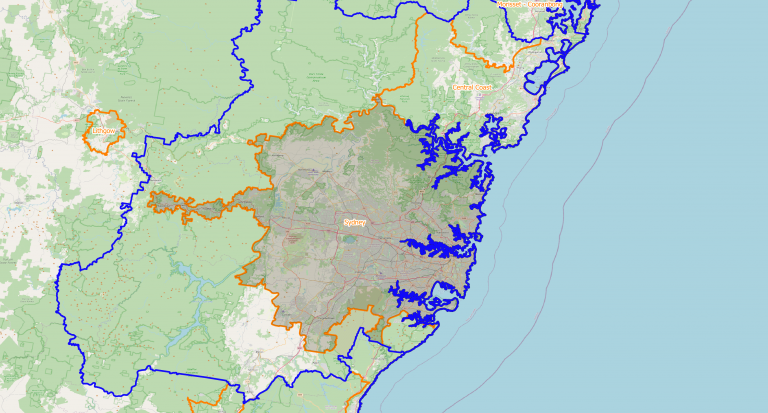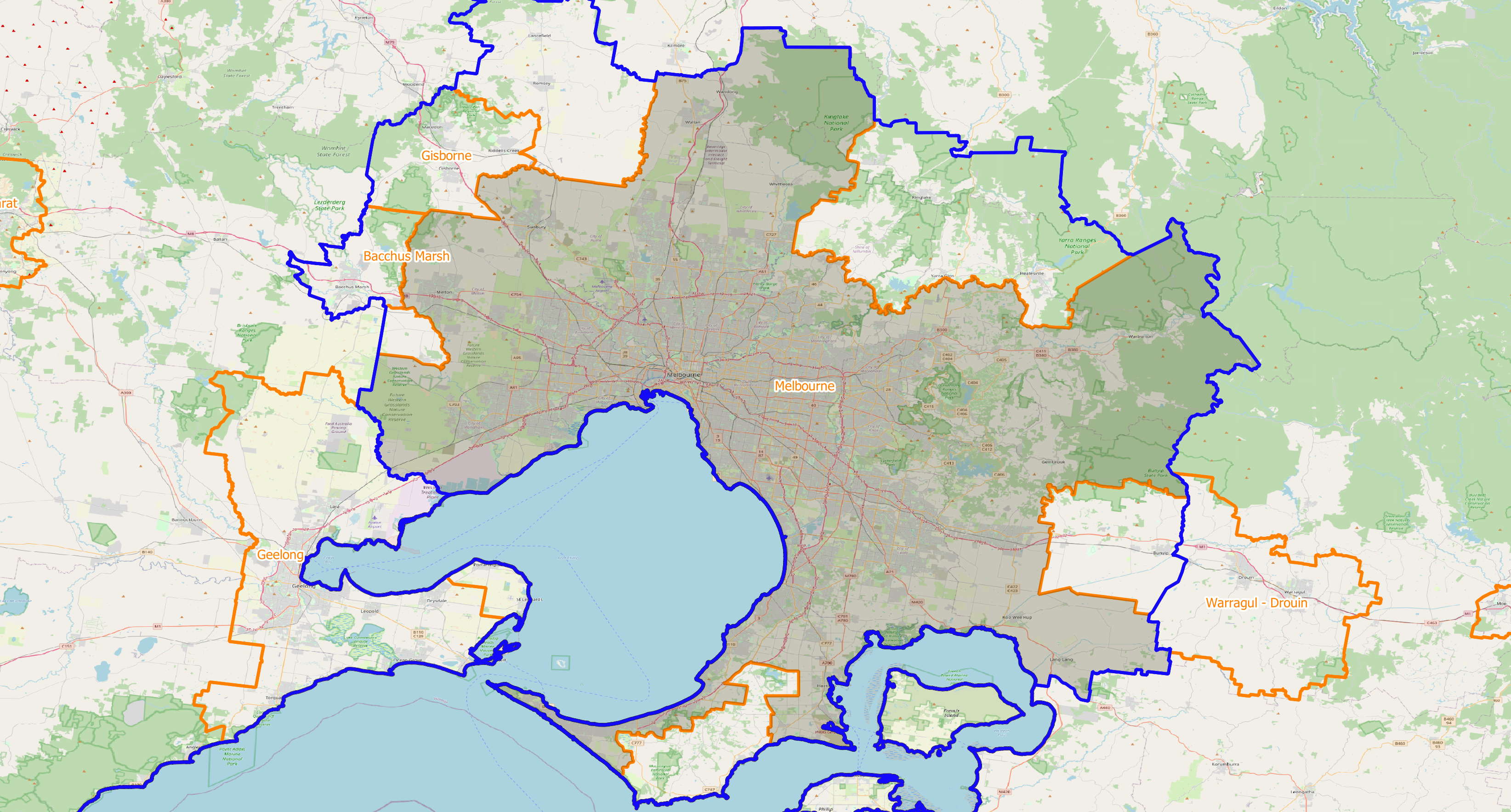Has Melbourne’s population really overtaken Sydney’s? With the latest Regional Population dataset from the ABS just out, Glenn digs into the detail behind the headlines. Hint: it’s all about how you define a city.
There was a lot of talk last week week about Melbourne’s population overtaking Sydney. Oddly, this was before we had the new data on this! There are two main definitions for the metropolitan areas of our two largest cities (indeed of all the capitals), and both are updated for 2022 in the Regional Population dataset, released by ABS on April 20th, 2023.
How do you define Sydney and Melbourne?
The answer to the question depends – as always – on where you draw the boundaries. The confusion comes about because of two competing definitions for what constitutes a city. The most commonly used one is called “Greater Capital City Statistical Area” or GCCSA. This is a stable, long-term boundary which includes the major metropolitan area and many outlying urban and rural districts surrounding our capitals. The ABS defines it based primarily on labour markets – it’s the catchment zone for workers where a large share work within the built up area of the city.
The second, lesser used definition is called Significant Urban Areas, and it is defined not just for our capitals, but for every urban area in Australia with at least 10,000 people. It’s made up of contiguous urban form SA2s (Statistical Area Level 2s – most people think of these as suburbs or towns, but they can be broader than that) with at least 10,000 population each (or with a smaller population but within 5km sealed road distance from a larger centre). These form a tighter boundary around the built up area, and exclude outlying rural parts of the GCCSA. There is another still tighter boundary based on SA1s called “Urban Centres” that only uses areas with urban population densities and land use – but this only applies to Census data, not intercensal population updates. There are other criteria as well, which you can find on the ABS definition page.
Melbourne has overtaken Sydney – but not on the most widely used definition
On the larger GCCSA boundary, Sydney remains Australia’s largest city, but on the smaller Significant Urban Area (SUA) boundary, Melbourne is now larger. This happened when ABS revised the SUA boundaries after the 2021 Census. There were a few changes, but the primary one which affected the population was the inclusion of several new SA2s on the western side of Melbourne in the Melbourne SUA. These are areas along the Western Highway, containing very new suburbs such as Bonnie Brook, Cobblebank-Strathtulloh, Aintree and Fraser Rise. Most Melbournians wouldn’t have heard of these suburbs, but they are growing rapidly, and lead to the City of Melton being the fastest growing LGA in Australia in 2022. This meant that the SA2s containing them were included in Melbourne for the first time. And suddenly the SA2s which formed part of previously separate urban centre of Melton, about 40km to the west of Melbourne were close enough to also be considered part of the contiguous urban area of Melbourne. So the approximately 75,000 people in here also got added to Melbourne’s population, as well as the fast growing areas in between.
It needs to be pointed out that Melton has been considered a part of the Greater Melbourne area by just about every other definition for at least the past 40 years. Melton has been an area of affordable housing functioning as a destination for first home buyers since the 1970s. But only now, with the building up of the suburbs in between Caroline Springs and Melton, is it close enough to include as a part of the Significant Urban Area.
How do the GCCSA and SUA boundaries differ?
These two maps show how the areas differ – GCCSA is in the blue, and SUA in the orange.
Sydney GCCSA and SUA

Melbourne GCCSA and SUA

There are other measures which define a city. The most common outside of Australia is the governmental definition, or “City limits”, particularly popular in the US. Using this definition would result in a population for Melbourne of about 150,000, as it would only look at the City of Melbourne LGA – tiny part of the metropolitan area. So we don’t use that one much here, preferring wider metropolitan measures.
The main reason that Sydney is smaller on the SUA definition is that the Greater Capital City includes the Central Coast (Gosford, Wyong, Terrigal, The Entrance etc.). These areas are well connected by road and rail to the city and form part of the Sydney labour market, and so are generally included as Greater Sydney. But due to the geography of Sydney, the wide Hawkesbury River separates it from the rest of Sydney, so based on the 5km and density rules it can never be part of the Sydney SUA, and is considered a separate SUA in its own right. Melbourne doesn’t have the same physical boundaries separating it from the outlying urban areas so these can fill in over time. You can see from the map that Melbourne’s SUA is a lot closer to the edge of the GCCSA than Sydney is, with the only excluded areas being relatively small population pockets – whereas the Central Coast is an urban area of over 350,000 people not included in the Sydney SUA.
How do other capitals fare with competing definitions?
It’s not just Melbourne and Sydney which have competing definitions. Here is how all the capital city populations look at June 2022, on the two main different measures.
Capital City Populations,
June 2022 |
Greater Capital City |
Significant Urban Area |
Difference |
Difference (%) |
| Sydney |
5,297,089 |
4,892,217 |
-404,872 |
-7.6% |
| Melbourne |
5,031,195 |
4,929,201 |
-101,994 |
-2.0% |
| Brisbane |
2,628,083 |
2,545,882 |
-82,201 |
-3.1% |
| Adelaide |
1,418,455 |
1,399,088 |
-19,367 |
-1.4% |
| Perth |
2,224,475 |
2,205,223 |
-19,252 |
-0.9% |
| Hobart |
252,693 |
231,707 |
-20,986 |
-8.3% |
| Darwin |
149,582 |
135,982 |
-13,600 |
-9.1% |
| Canberra |
456,692 |
493,435 |
36,743 |
8.0% |
You can see that Sydney and Melbourne are very close on both measures, and no other Australian city comes close. You can also see that the Sydney SUA is more than 400,000 people smaller than the Greater Capital City area, a discrepancy more than all the other capitals combined (though in percentage terms, Hobart and Darwin have a greater difference). All the SUAs are smaller than their respective Greater Capital City areas, with one exception. The Canberra SUA includes Queanbeyan, which is not a part of the Greater Capital City area since it is across a state border. So the Canberra SUA (technically called Canberra-Queanbeyan) is larger in population.
There is another school of thought which considers Greater Sydney to be part of a still larger urban area including Newcastle and Wollongong, which apart from natural barriers now sprawls over 250km from Raymond Terrace in the north to Kiama in the south. By this definition the Sydney-Newcastle-Wollongong urban area is over 6.1 million people and well ahead of Melbourne, which would be about 5.3 million if you did the equivalent exercise and went outwards to include Geelong, Warragul, Gisborne and a few other outlying centres.
In the end, the debate is fairly moot, and it’s only the old Sydney–Melbourne rivalry that keeps it going. Don’t let the facts get in the way of a good story though! Probably the most accurate thing we can say is that both cities have a similar population at around 5 million and are likely to be experiencing similar issues, including traffic congestion, housing affordability etc. But that won’t stop anyone from comparing!











